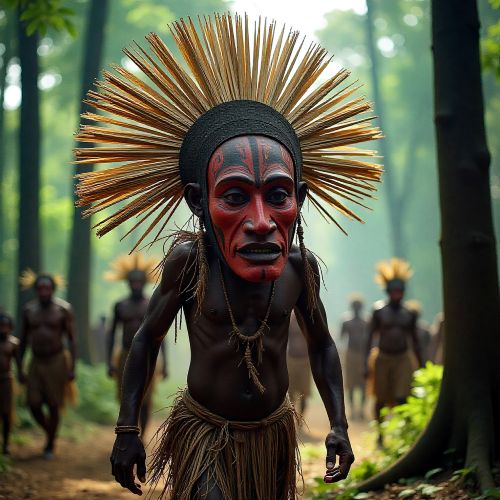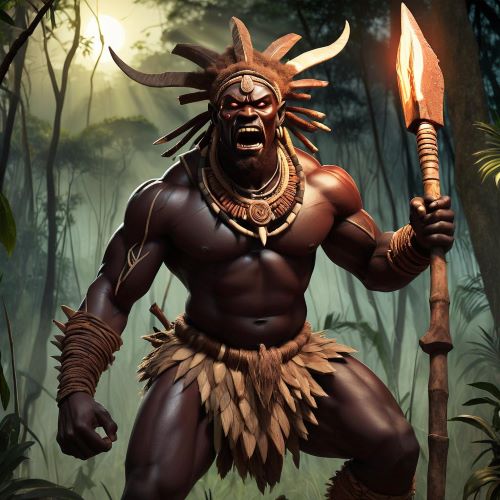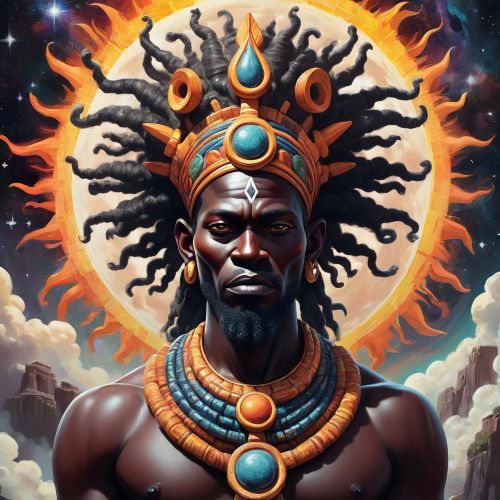Teke & Yaka Mythology
Teke and Yaka mythology reflects the vibrant spiritual landscape of Central Africa, rooted in the ancestral traditions of the Teke (Bateke) and Yaka peoples who inhabit regions of the Democratic Republic of the Congo, Republic of the Congo, and Angola. Though distinct ethnic groups, both share a worldview that emphasizes the sacred unity between humans, nature, and the spirit world. Their mythologies are deeply moral and symbolic, conveying not only cosmological origins but also the responsibilities of individuals to maintain harmony within their communities and with the invisible forces that sustain life.
Teke mythology centers on a universe governed by Nzambi, the supreme creator, whose power flows through the ancestral spirits and natural world. He is distant but ever-present, having established the laws of creation and balance. Below Nzambi are numerous nature spirits, each associated with elements such as rivers, trees, thunder, or fertility. These beings, known as Nkisi or Bilumbu, act as intermediaries between humans and the divine, guiding daily life and protecting the community. Ancestors, or Bisimbi, remain ever vigilant—blessing or punishing the living according to their respect for tradition. For the Teke, the world is not divided into sacred and profane realms; rather, it is a continuous spiritual field where every action carries divine consequence.
The Teke also view the land itself as sacred, inhabited by the spirits of past generations. Rituals involving carved ancestor figures, symbolic masks, and offerings of food or libations are performed to ensure harmony between the living and the dead. These ceremonies often take place at family shrines or in forest clearings considered spiritual crossroads. Central to Teke cosmology is the concept of moral reciprocity—to live well is to maintain balance with nature and with the ancestors. When this balance is broken, illness, misfortune, or drought may follow, requiring the intervention of a spiritual healer or Nganga to restore equilibrium through divination and ritual cleansing.
Yaka mythology, while sharing similar foundations, is known for its powerful ritual symbolism and complex spiritual hierarchy. The Yaka believe that the world was created and is continually sustained by a divine force known as Kalunga, the energy that connects the living and the ancestral realms. Spirits of the dead, known as Bisimba, play an active role in human life, influencing health, success, and fate. The Yaka are also famous for their intricate ritual masks used in initiation ceremonies, where myth and performance merge to teach moral values and social roles. Each mask embodies a spirit or ancestral presence, and its dance dramatizes the eternal dialogue between the human and spirit worlds.
Both Teke and Yaka mythology emphasize transformation as a divine principle—death is not an end but a passage, and misfortune is not punishment but a reminder to realign with the moral order of the universe. Through their myths, symbols, and ceremonies, these cultures express a profound understanding of balance, identity, and spiritual continuity. Even today, the sacred art and oral traditions of the Teke and Yaka people stand as living expressions of Africa’s ancient wisdom: that life, in all its forms, is part of a single cosmic rhythm.





